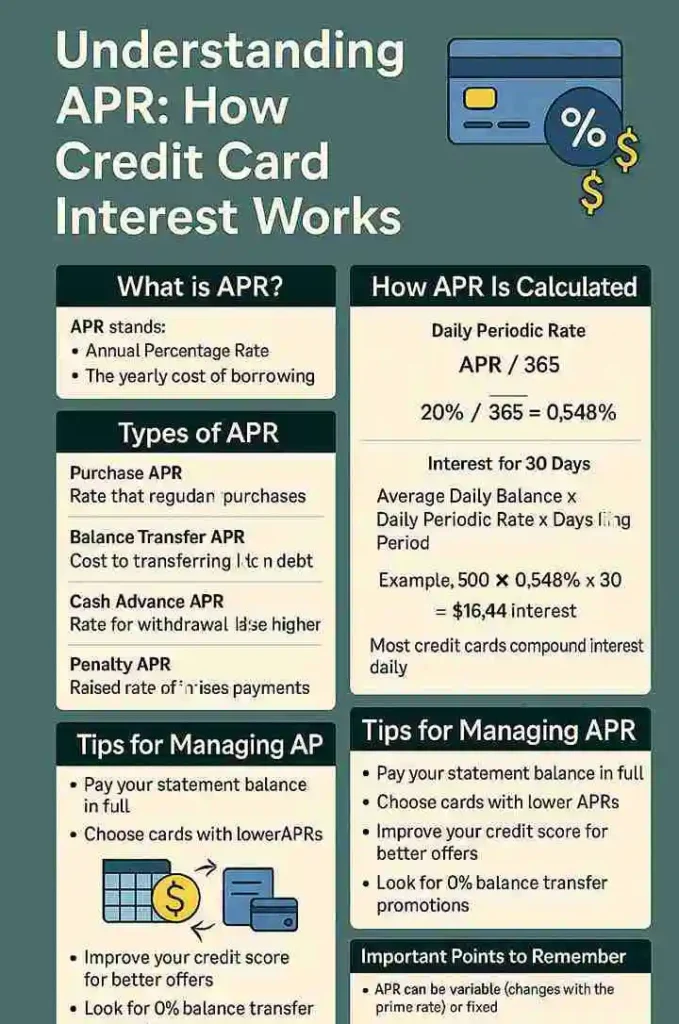Understanding APR: How Credit Card Interest Works
If you use a credit card, knowing how credit card interest works is crucial to managing your finances effectively. The Annual Percentage Rate (APR) is the rate lenders charge when you carry a balance from month to month, and it directly impacts the cost of borrowing. This guide will help you understand what APR means, how it’s calculated, and how it influences your credit card payments. By gaining a clear understanding of how credit card interest works, you’ll be better equipped to make informed financial decisions, avoid unnecessary debt, and take control of your credit.
What is APR?
APR vs Interest Rate
APR stands for Annual Percentage Rate, and while it’s often used interchangeably with interest rate, they’re not quite the same. APR includes the interest plus any applicable fees, offering a more comprehensive view of your borrowing cost.
Meaning of Annual Percentage Rate
It’s the yearly cost of borrowing money expressed as a percentage. For credit cards, it’s the rate you’re charged if you carry a balance beyond the grace period.
Types of APR in Credit Cards
Purchase APR
The most common type it applies to purchases made with your credit card if you don’t pay the full balance each month.
Balance Transfer APR
Charged on debt moved from one card to another. Some cards offer 0% introductory APR for a limited time.
Cash Advance APR
This rate is typically higher and starts accruing immediately—there’s no grace period for cash advances.
Penalty APR
Triggered by missed payments or violations of terms, this APR can jump to 29.99% or more and stay there indefinitely.

How Is APR Calculated?
Daily Periodic Rate
APR is broken down into a daily rate:
java
CopyEdit
Daily Rate = APR ÷ 365
For a 20% APR:
sql
CopyEdit
20 ÷ 365 = 0.0548% per day
Formula with Example
If you carry a $1,000 balance for 30 days at 20% APR:
bash
CopyEdit
$1,000 × 0.000548 × 30 = $16.44 interest
Compounding Interest Explained
Most credit cards compound interest daily, meaning you pay interest on both the principal and accumulated interest.
How Credit Card Companies Use APR
When Interest Is Charged
Interest kicks in only if you carry a balance past your due date. If you pay your statement balance in full, you’re typically not charged interest.
Grace Periods
Usually 21–25 days from the end of your billing cycle. If used well, you can avoid interest entirely.
Variable vs Fixed APR
- Variable APR fluctuates with the prime rate.
Fixed APR remains the same but is rare in today’s credit card market.
How APR Affects Your Monthly Payments
Interest on Carried Balances
Even small balances can grow fast. For example, $2,000 at 22% APR can accrue over $400 in annual interest if not managed.
Cost of Minimum Payments
Paying the minimum may keep your account in good standing but extends the repayment period and increases the total interest paid.
What Is a Good APR in 2025?
Average APRs in the Market
As of 2025, average APRs range from 16% to 28%, depending on your credit score and card type.
What to Aim For
- Excellent credit: under 17% APR
- Fair credit: 20–24%
- Poor credit: 25%+
How to Lower Your Credit Card APR
- Negotiate with issuers – Especially if your credit has improved
- Improve your credit score – Better scores get better offers
- Use balance transfer offers – Look for 0% intro APR promotions
APR and Your Credit Score
Indirect Effects
APR doesn’t directly affect your score, but high interest rates can lead to growing balances, increasing your utilization ratio, which lowers your score.
Common APR Mistakes to Avoid
- Ignoring terms and conditions
- Making minimum payments only
- Taking cash advances without knowing the cost
- Triggering penalty APRs
Tools to Help Manage APR
- NerdWallet APR calculator
- Mint – for tracking balances and due dates
- Credit Karma – for viewing APRs and credit offers
- Experian Boost – helps improve scores to get better APRs
Frequently Asked Questions
Conclusion
Understanding APR is essential to using credit cards wisely. It’s not just about avoiding fees, it’s about maximizing your financial health. Pay balances in full, avoid high-interest situations, and use the right tools to monitor your APR. A little awareness goes a long way in saving you money and building strong credit.
